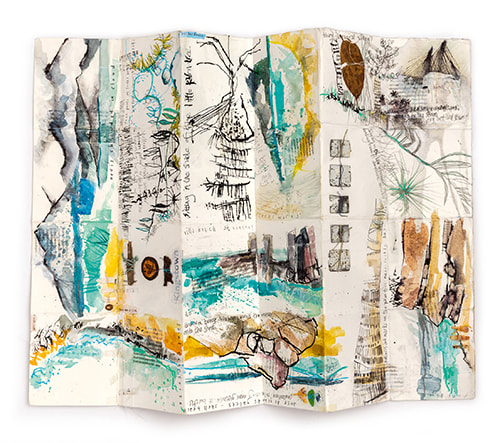Sketchbooks can prove a contentious subject. There are those that do, those that don’t and those that dabble. Shelley Rhodes is definitely in the ‘those that do’ camp and she keeps such beautiful sketchbooks that you will find yourself coveting such prize specimens. Shelley Rhodes trained as a graphic designer. There’s a brief reference to it near the end of the book but this news brings everything into perspective. The clarity and purpose behind her explorations draw from the discipline of graphic design but run alongside the freedom of her artistic expression. It is these two elements coming together that creates such a beautiful selection of work. The book, Sketchbook Explorations, is an exploration not just of Shelley Rhodes’s own books but of how sketchbooks can aid and help develop an artistic practice. Whether being used as a visual diary of daily practice, for the development of particular pieces of work or experiments on themes, Shelley has a book for them all. By sharing these with the reader, it opens up the world of sketchbooks so that you can see how other artists use them and how you might best use them for yourself. Turns out, you can have more than one… The books incorporate drawing, colour, mixed-media, found objects, collections and photographs. They cover themes such as coastal and urban decay, holiday memories, or mark-making. The essence of each book is to find its purpose and run with it. So, the visual diaries of holidays become an artistic expression of the experience of place, may use found objects from that place to make marks or keep as a memento. Observations of the surroundings may be noted, colours or plants added or more abstract impressions sketched and painted. Found objects are not kept hidden away but arranged in collections or boxes, rearranged or stuck directly into the sketchbook pages (spiralbound books come in handy here for bulky pages). A range of different sketchbook types are demonstrated – bought books, made books, tag books or index cards that make up reference libraries, scrolls, fabric pages, and extra long ‘walk’ sketchbook pages. There are numerous ideas presented and you will see the world open up before you as the options available are laid out. There are also suggestions of how to add content to your books with mark-making, sketching exercises, writing, making tools, altering pages. So much that you cannot help but be inspired.
Shelley Rhodes’s work itself is awe-inspiring but she also has carefully chosen other fascinating artists to feature and share their work practices. This makes the book something of a powerhouse of sketchbook demonstrations with the addition of Debbie Lyddon, Helen Terry and Diana Harrison, particularly in the area of mark-making. For visual diaries and work development, Jean Draper, Gwen Hedley, Ines Seidel and Jan Miller all produce work that is exquisite as work in progress and clearly show how work evolves from what is often a simple idea. What impresses most about this book is the attention to detail and clarity of the work, the way the author and all artists compose their sketchbooks and are so attuned to their practice. The approach is intuitive but ordered with a clear purpose. Shelley Rhodes, amongst all the wonderful art and books, also reminds us that the sketchbooks can also be a private matter. We can choose what to show the world. This gives the reader the security to know that the sketchbook is allowed to be the place to make mistakes that no-one needs to know about. Artistic practice can be worked and perfected until you find your own way but if you need help in clearing the first hurdle, I cannot think of a better book to recommend.
1 Comment
|
AuthorBook Reviews on a variety of arts-related subjects. Please see Book Review page for an index of subject matter. Archives
March 2023
Categories |
Proudly powered by Weebly






 RSS Feed
RSS Feed